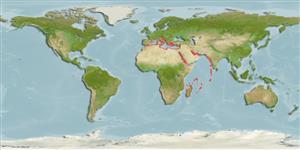Common names from other countries
Environment: milieu / climate zone / depth range / distribution range
Ecologia
; estuarina; intervalo de profundidade 15 - 40 m (Ref. 107883). Subtropical
Western Indian Ocean and the Mediterranean Sea.
Length at first maturity / Tamanho / Peso / Idade
Maturity: Lm ? range ? - ? cm
Intertidal lagoon, on mudflats. Favors soft mud and may sometimes climb mangrove pneumatophores or shelter under loose flaps of the black mats of cyanobacteria in the uppermost intertidal zone (Ref. 101158). Detritus feeder (Ref. 115396). Scraper herbivore (Ref. 115397).
Life cycle and mating behavior
Maturidade | Reprodução | Desova | Ovos | Fecundidade | Larvas
Members of the order Neotaenioglossa are mostly gonochoric and broadcast spawners. Life cycle: Embryos develop into planktonic trocophore larvae and later into juvenile veligers before becoming fully grown adults.
Templado, J. and R. Villanueva. 2010. (Ref. 85339)
Status na Lista Vermelha da IUCN (Ref. 130435)
Status no CITES (Ref. 108899)
Not Evaluated
Not Evaluated
Perigo para os humanos
Harmless
Uso pelos humanos
| FishSource |
Ferramentas
Mais informação
Idade/Tamanho
Crescimento
Comprimento-peso
Comprimento-comprimento
Morfologia
Larvas
Abundância
Fontes da internet
Estimates based on models
